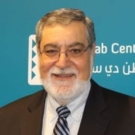Speaker

Mehran Kamrava
Professor and Director of the Center for International and Regional Studies
Georgetown University - Qatar
Moderator
Event Summary
Washington, DC — December 6, 2018 — Arab Center Washington DC (ACW), a nonprofit, independent, and nonpartisan think tank that focuses on US policy and developments in the Arab region, hosted Dr. Mehran Kamrava, Professor and Director of the Center for International and Regional Studies at Georgetown University–Qatar, to discuss his latest book Inside the Arab State (Oxford University Press, 2018). ACW Executive Director Khalil Jahshan introduced the author, saying that the book is one of the most authoritative explanations of what is happening in Arab states today since the Arab Spring of 2011.
Kamrava said that seven years after massive protests rocked capitals throughout the Middle East, the world is still trying to understand the nature of the Arab Spring. He said that a number of important questions have animated the book and motivated him to write it, most consequential of which were “what happened?” and “why did the Arab Spring turn out the way it did?” He explained that looking at the phenomenon, he examined the nature of social movements as motivators of revolutions. What he found in the Arab Spring cases is that for different reasons and to different degrees some of these movements succeeded (Tunisia), others were simply smothered (Bahrain), and yet others led to open and destructive civil wars (Yemen and Syria).
Kamrava also found that in all of the cases of the Arab Spring, the stance of coercive institutions––armies, police forces, intelligence services, and others––played a determinate role in how the state and the regime responded to protests. The regimes whose armed forces found their interest in staying with them survived and those that lost that support lost. There, however, was a third kind of armed forces that simply disintegrated, as happened in the Libyan and Yemeni cases. What determined this stance by coercive institutions was how they saw their corporate interests and how they could protect them. In the Egyptian case, the military dropped Mubarak when it saw hundreds of thousands of people in the streets and wanted to be on their side to preserve its interests; but when Mohammed Morsi threatened these, the armed forces toppled him.
Thus far, Kamrava sees optimism in the Tunisian case where the post-Arab Spring elites found that bargaining and compromise work. He, however, cautioned that the last chapter in the Tunisian revolution has not yet been written and counseled that Tunisia should be supported so that it can advance its democratic development. On the other hand, Kamrava was pessimistic about the future of democracy in the Arab world in general and said that an Arab Spring 2.0 is unlikely for the foreseeable future. He based this last prediction on data from the Arab Opinion Index polls conducted over the last six years that showed that the Arab public likes democracy but thinks that it is stymied by the regimes and their states.
Finally, to Kamrava, there is “negative equilibrium” and “contested terrain” that now exist between some Arab states and their citizens. More troubling, however, is that the Arab Spring may have failed to instill the “democratic ideals” among the populace that would help in implementing democratic governance in practice. To him, democratic governance may be out of reach for the moment because, below the surface, the Arabs’ idea of democracy is not inclusive toward religious minorities or political opponents. Additionally, Arabs today are most concerned about the economy and the security situation, in that order.
Event Photos

